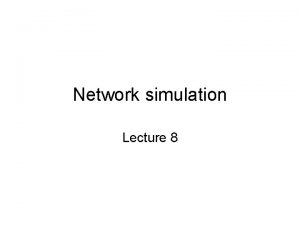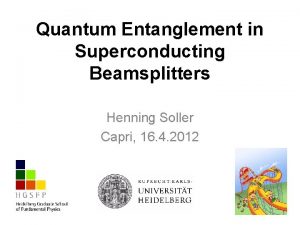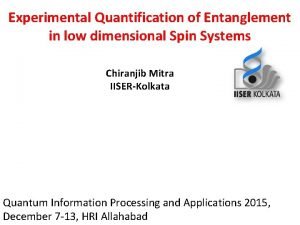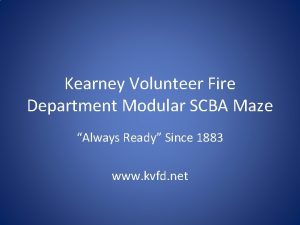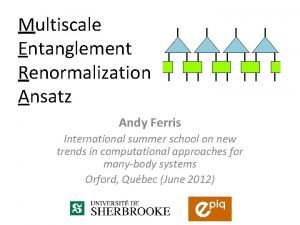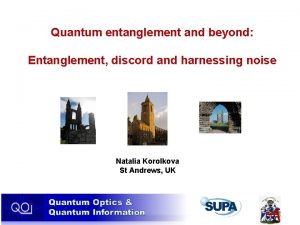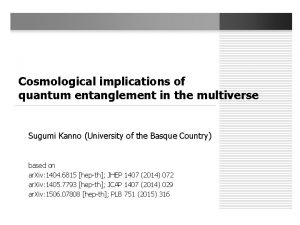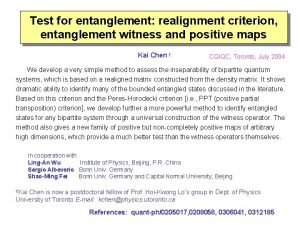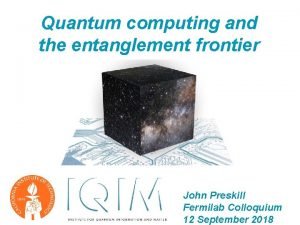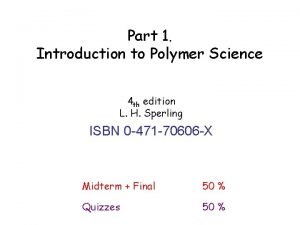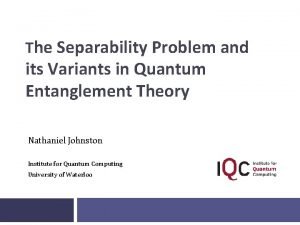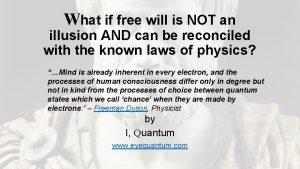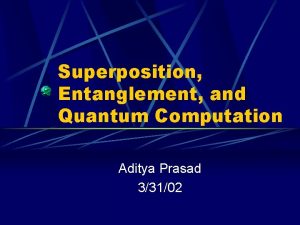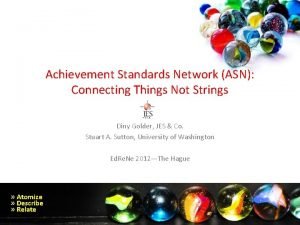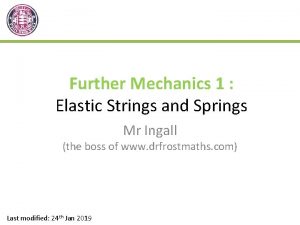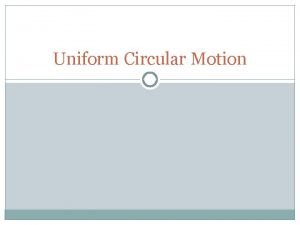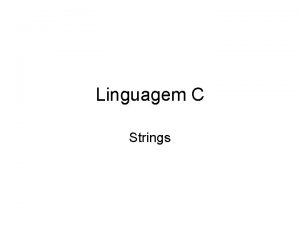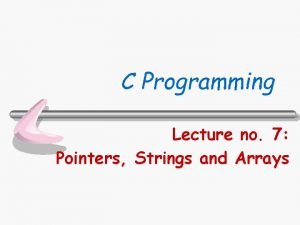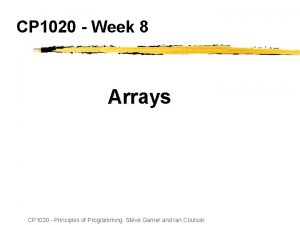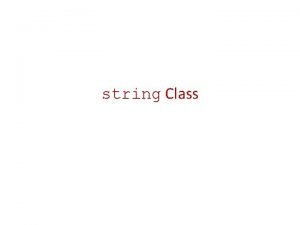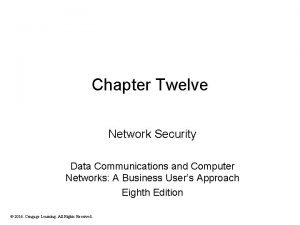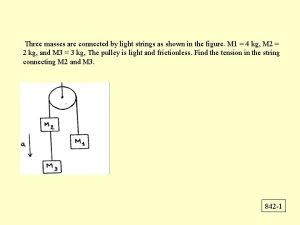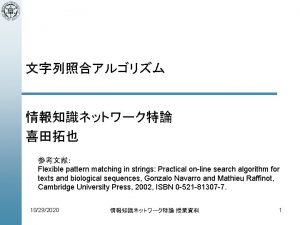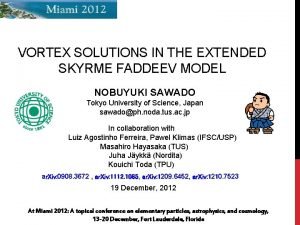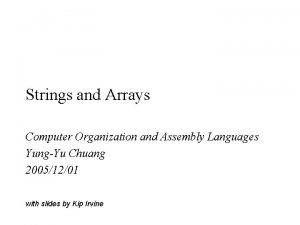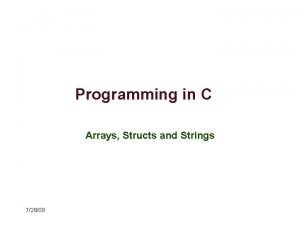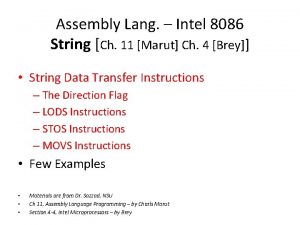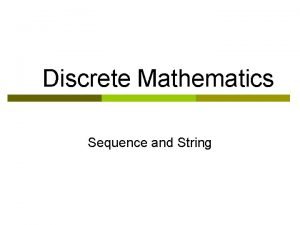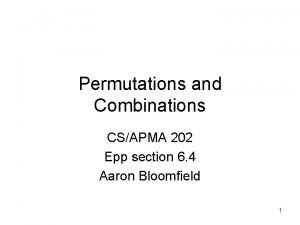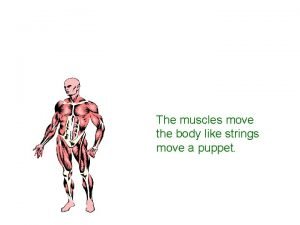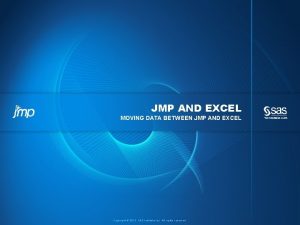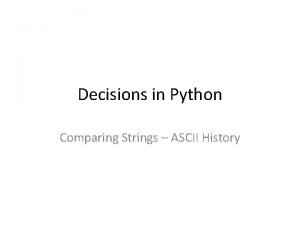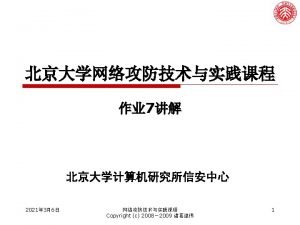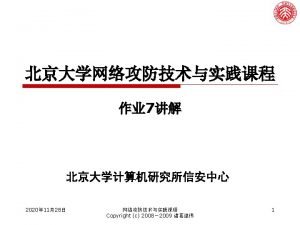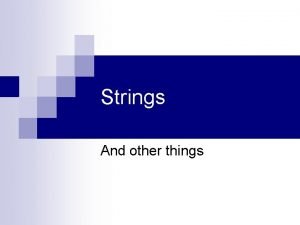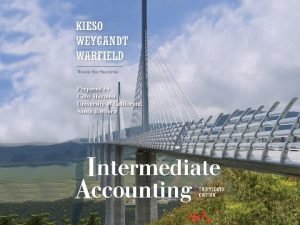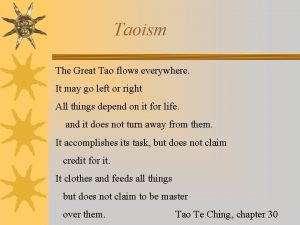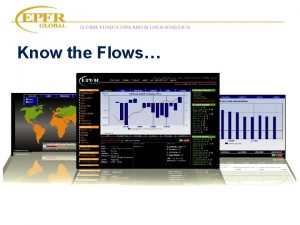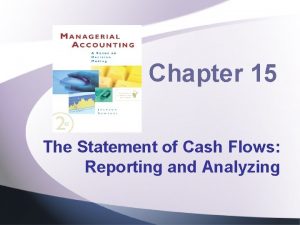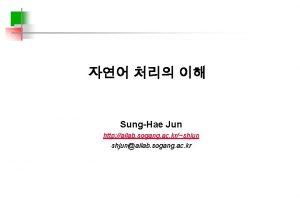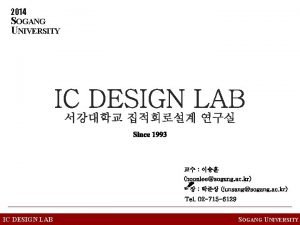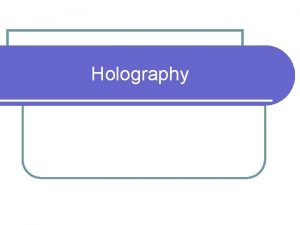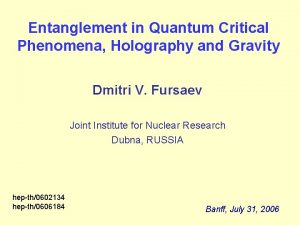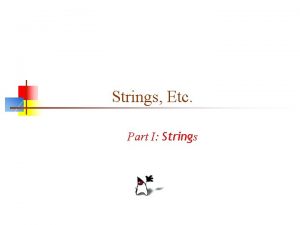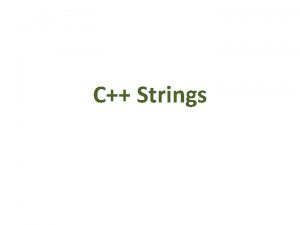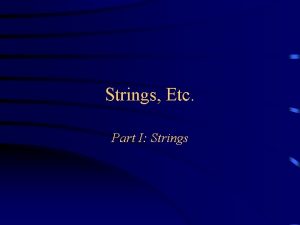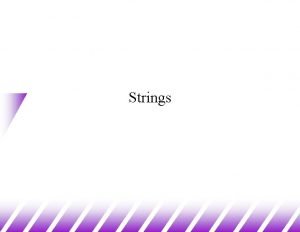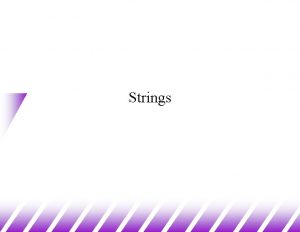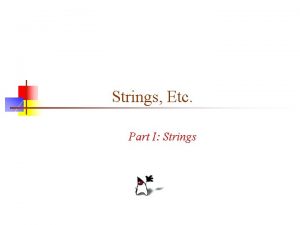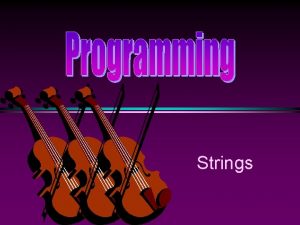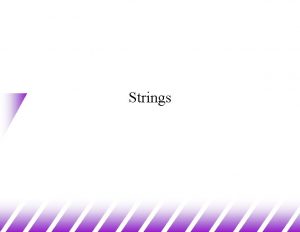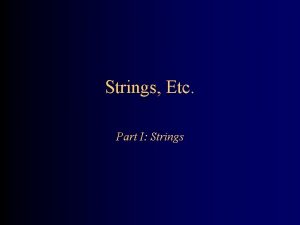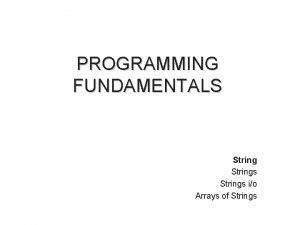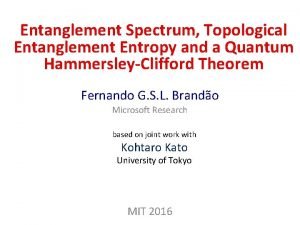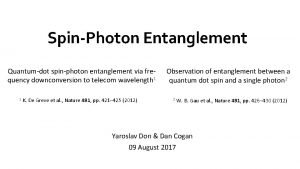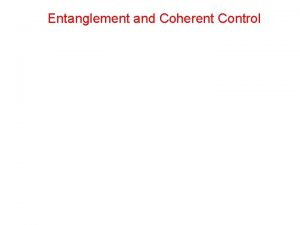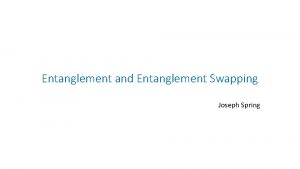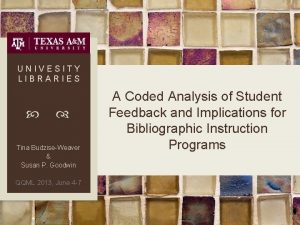RG Flows Entanglement Holography Strings 2013 Sogang Univesity



















































- Slides: 51

RG 재Flows, 규격화Entanglement 군 흐름, 녹채 & Holography 과 홀로그래피 Strings 2013 Sogang Univesity, Seoul Korea, 26 -29 June 2013

New Dialogues in Theoretical Physics: Particle Physics Statistical Mechanics RRenormalization Group Flows Quantum Field Theory Holographic RG Flows Many Body Theory Quantum Information Entanglement Condensed Matter Theory Holography String Theory Quantum Gravity

Quantum Entanglement Einstein-Podolsky-Rosen Paradox: • properties of pair of photons connected, no matter how far apart they travel “spukhafte Fernwirkung” = spooky action at a distance Quantum Information: entanglement becomes a resource for (ultra)fast computations and (ultra)secure communications Condensed Matter: key to “exotic” phases and phenomena, e. g. , quantum Hall fluids, unconventional superconductors, quantum spin fluids, . .

Quantum Entanglement Einstein-Podolsky-Rosen Paradox: • properties of pair of photons connected no matter how far apart they travel “spukhafte Fernwirkung” = spooky action at a distance compare: No Entanglement!! Entangled!!

Entanglement Entropy: • general diagnostic: divide quantum system into two parts and use entropy as measure of correlations between subsystems • procedure: • divide system into two subsystems, eg, A and B • trace over degrees of freedom in subsystem B • remaining dof in A are described by a density matrix • calculate von Neumann entropy: compare: No Entanglement!! Entangled!!

New Dialogues in Theoretical Physics: Particle Physics Statistical Mechanics Renormalization Group Flows Quantum Field Theory Holographic RG Flows Many Body Theory Quantum Information Entanglement Condensed Matter Theory Holographic Entanglement Entropy String Theory Quantum Gravity

Entanglement Entropy 2: • in the context of holographic entanglement entropy, SEE is applied in the context of quantum field theory • in QFT, typically introduce a (smooth) boundary or entangling surface which divides the space into two separate regions • integrate out degrees of freedom in “outside” region • remaining dof are described by a density matrix calculate von Neumann entropy: B A

Entanglement Entropy 2: • remaining dof are described by a density matrix calculate von Neumann entropy: B A R • result is UV divergent! dominated by short-distance correlations • must regulate calculation: = short-distance cut-off = spacetime dimension • careful analysis reveals geometric structure, eg,

Entanglement Entropy 2: • remaining dof are described by a density matrix calculate von Neumann entropy: B A R • must regulate calculation: = short-distance cut-off = spacetime dimension • leading coefficients sensitive to details of regulator, eg, • find universal information characterizing underlying QFT in subleading terms, eg,

(Ryu & Takayanagi `06) Holographic Entanglement Entropy: Ad. S boundary A Ad. S bulk spacetime B boundary conformal field theory gravitational potential/redshift • “UV divergence” because area integral extends to looks like BH entropy!

(Ryu & Takayanagi `06) Holographic Entanglement Entropy: Ad. S boundary A B cut-off in boundary CFT: regulator surface • “UV divergence” because area integral extends to centralintroduce charge “regulator surface” at large radius: • as usual, (counts dof) short-distance cut-off in boundary theory: “Area Law”

(Ryu & Takayanagi `06) Holographic Entanglement Entropy: Ad. S boundary A B cut-off in boundary CFT: regulator surface general expression (as desired): (d even) (d odd) universal contributions

Holographic Entanglement Entropy: (Ryu & Takayanagi `06) conjecture Extensive consistency tests: 1) leading contribution yields “area law” 2) recover known results for d=2 CFT: 3) (Holzhey, Larsen & Wilczek) (Calabrese & Cardy) in a pure state and 4) for thermal bath: both yield same bulk surface V

Holographic Entanglement Entropy: (Ryu & Takayanagi `06) conjecture Extensive consistency tests: 5) strong sub-additivity: (Headrick & Takayanagi) [ further monogamy relations: Hayden, Headrick & Maloney] 6) for even d, connection of universal/logarithmic contribution in SEE to central charges of boundary CFT, eg, in d=4 c a (Hung, RM & Smolkin) 7) derivation of holographic EE for spherical entangling surfaces (Casini, Huerta & RM, RM & Sinha)

Holographic Entanglement Entropy: (Ryu & Takayanagi `06) conjecture Extensive consistency tests: new proof!!! (Lewkowycz & Maldacena) • generalization of Euclidean path integral calc’s for SBH, extended to “periodic” bulk solutions without Killing vector • for Ad. S/CFT, translates replica trick for boundary CFT to bulk • at , linearized gravity eom demand: shrinks to zero on an extremal surface in bulk • evaluating Einstein action yields for extremal surface

Topics currently trending in Holographic SEE: (Ryu & Takayanagi `06 111 cites in past year of total of 317) • thermodynamic properties of of SEESfor excited states EE for (Bhattacharya, Nozaki, Takayanagi&&Ugajin; . . . ) (Bhattacharya, Nozaki, • “entanglement tsunami” – probe of holo-quantum quenches (Liu & Suh) • probe of large-N phase transitions at finite volume (Johnson) • phase transitions in holographic Renyi entropy • holographic SEE in higher spin gravity (Belin, Maloney & Matsuura) (Ammon, Castro & Iqbal; de Boer & Jottar) • holographic SEE beyond classical gravity (Barrella, Dong, Hartnoll & Martin) • probing causal structure in the bulk (Hubeny, Maxfield, Rangamani & Tonni) • holographic Renyi entropy for disjoint intervals (Faulkner; Hartman) ● ● ●

New Dialogues in Theoretical Physics: Particle Physics Statistical Mechanics John Preskill (quant-ph/9904022) “Quantum information and physics: some future directions” ? ? Renormalization Group Flows Quantum Field Theory Holographic RG Flows Many Body Theory Quantum Information Entanglement Condensed Matter Theory Holographic Entanglement Entropy String Theory Quantum Gravity

Zamolodchikov c-theorem (1986): • renormalization-group (RG) flows can seen as one-parameter motion in the space of (renormalized) coupling constants with beta-functions as “velocities” • for unitary, renormalizable QFT’s in two dimensions, there exists a positive-definite real function of the coupling constants : 1. monotonically decreasing along flows: 2. “stationary” at fixed points : : 3. at fixed points, it equals central charge of corresponding CFT

with Zamolodchikov's framework: BECOMES

with Zamolodchikov's framework: ● ● Consequence for any RG flow in d=2:

C-theorems in higher even dimensions? ? d=2: d=4: and • in 4 dimensions, have three central charges: • do any of these obey a similar “c-theorem” under RG flows? -theorem: is scheme dependent (not globally defined) -theorem: there are numerous counter-examples Cardy’s conjecture (1988): -theorem: for any RG flow in d=4, • numerous nontrivial examples, eg, perturbative fixed points (Jack & Osborn), SUSY gauge theories (Anselmi et al; Intriligator & Wecht) • JP: perhaps QI can provide insight into c-theorems for odd dim’s

Entanglement proof of c-theorem: (Casini & Huerta ‘ 04) • c-theorem for d=2 RG flows can be established using unitarity, Lorentz invariance and strong subaddivity inequality: • define: • for d=2 CFT: (Holzhey, Larsen & Wilczek) (Calabrese & Cardy) • hence it follows that:

New Dialogues in Theoretical Physics: Particle Physics Statistical Mechanics c theorems? ? Renormalization Group Flows Quantum Field Theory Holographic RG Flows Many Body Theory Quantum Information Entanglement Condensed Matter Theory Holographic Entanglement Entropy String Theory Quantum Gravity

(Girardello, Petrini, Porrati and Zaffaroni, hep-th/9810126) (Freedman, Gubser, Pilch & Warner, hep-th/9904017) Holographic RG flows: • imagine potential has stationary points giving negative Λ • consider metric: • at stationary points, Ad. S 5 vacuum: with • HRG flow: solution starts at one stationary point at large radius and ends at another at small radius – connects CFTUV to CFTIR ● ● UV IR ●

(Girardello, Petrini, Porrati and Zaffaroni, hep-th/9810126) (Freedman, Gubser, Pilch & Warner, hep-th/9904017) Holographic RG flows: • for general flow solutions, define: Einstein equations null energy condition • at stationary points, and hence • using holographic trace anomaly: (e. g. , Henningson & Skenderis) supports Cardy’s conjecture • for Einstein gravity, central charges equal :

(Freedman, Gubser, Pilch & Warner, hep-th/9904017) Holographic RG flows: • same story is readily extended to (d+1) dimensions • defining: Einstein equations null energy condition • at stationary points, • using holographic trace anomaly: for even d! what about odd d? and so central charges (e. g. , Henningson & Skenderis)

Improved Holographic RG Flows: • add higher curvature interactions to bulk gravity action provides holographic field theories with, eg, so that we can clearly distinguish evidence of a-theorem (Nojiri & Odintsov; Blau, Narain & Gava) • construct “toy models” with fixed set of higher curvature terms (where we can maintain control of calculations) What about the swampland? • constrain gravitational couplings with consistency tests (positive fluxes; causality; unitarity) and use best judgement • ultimately one needs to fully develop string theory for interesting holographic backgrounds! • “if certain general characteristics are true for all CFT’s, then holographic CFT’s will exhibit the same features”

Toy model: (RM & Robinsion; RM, Paulos & Sinha) with • three dimensionless couplings: • again, gravitational eom and null energy conditon yield: (RM & Sinha) where with central charge of boundary CFT • toy model supports for Cardy’s conjecture in four dimensions

(RM & Sinha) • for holographic RG flows with general d, find: where with • trace anomaly for CFT’s with even d: (Deser & Schwimmer) • verify that we have precisely reproduced central charge (Henningson & Skenderis; Nojiri & Odintsov; Blau, Narain & Gava; Imbimbo, Schwimmer, Theisen & Yankielowicz) agrees with Cardy’s conjecture What about odd d? ?

(Casini, Huerta & RM; RM & Sinha) Holographic Entanglement Entropy: • SEE for CFT in d-dim. flat space and choose Sd-2 with radius R • conformal mapping relate to thermal entropy on with R ~ 1/R 2 and T=1/2πR • holographic dictionary: thermal bath in CFT = black hole in Ad. S • desired “black hole” is a hyperbolic foliation of Ad. S • bulk coordinate transformation implements desired conformal transformation on boundary • apply Wald’s formula (for any gravity theory) for horizon entropy: universal contributions: for even d for odd d

C-theorem conjecture: (RM & Sinha) • identify central charge with universal contribution in entanglement entropy of ground state of CFT across sphere Sd-2 of radius R: for even d for odd d (any gravitational action) • for RG flows connecting two fixed points (“unitary” models) unified framework to consider c-theorem for odd or even d connect to Cardy’s conjecture: for any CFT in even d

(Jafferis, Klebanov, Pufu & Safdi) F-theorem: • examine partition function for broad classes of 3 -dimensional quantum field theories on three-sphere (SUSY gauge theories, perturbed CFT’s & O(N) models) • in all examples, F= – log Z(S 3)>0 and decreases along RG flows conjecture: • also naturally generalizes to higher odd d • coincides with entropic c-theorem (Casini, Huerta & RM) • focusing on renormalized or universal contributions, eg, • generalizes to general odd d:

Entanglement proof of F-theorem: (Casini & Huerta ‘ 12) • F-theorem for d=3 RG flows established using unitarity, Lorentz invariance and strong subaddivity • geometry more complex than d=2: consider many circles intersecting on null cone (no corner contribution from intersection in null plane) • define: • for d=3 CFT: • hence it follows that:

(Liu & Mezei) “Renormalized” Entanglement Entropy: • SEE is UV divergent, so must take care in defining universal term • divergences determined by local geometry of entangling surface with covariant regulator, eg, • can isolate finite term with appropriate manipulations, eg, d=3: c-function of d=4: • unfortunately, holographic experiments indicate good c-functions for d>3 Casini & Huerta are not

(Casini, Huerta, RM & Yale) “Renormalized” Entanglement Entropy 2: • SEE is UV divergent, so must take care in defining universal term • mutual information is intrinsically finite and so offers alternative approach to regulate SEE • with and • choice ensures that a 3 is not polluted by UV fixed point • naturally extends to defining ad in higher odd dimensions • for d=3, entropic proof of F-theorem can be written in terms of mutual information

(Komargodski & Schwimmer; see also: Luty, Polchinski & Rattazzi) a-theorem and Dilaton Effective Action (Schwimmer & Theisen) • analyze RG flow as “broken conformal symmetry” • couple theory to “dilaton” (conformal compensator) and organize effective action in terms of diffeo X Weyl invariant: • follow effective dilaton action to IR fixed point, eg, : ensures UV & IR anomalies match • with , only contribution to 4 pt amplitude with null dilatons: • dispersion relation plus optical theorem demand:

(Solodukhin) a-theorem, Dilaton and Entanglement Entropy • find anomaly contribution for SEE • for conformally flat background and flat entangling surface, • can express coefficient in terms of spectral density for • analogous to effective-dilaton-action analysis for d=2 (Komargodski)

Questions: • how much of Zamalodchikov’s structure for d=2 RG flows extends higher dimensions? d=3 entropic c-function not always stationary at fixed points (Klebanov, Nishioka, Pufu & Safdi) • can c-theorems be proved for higher dimensions? eg, d=5 or 6 dilaton-effective-action would require subtle refinement for d=6 (Elvang, Freedman, Hung, Kiermaier, RM & Theisen; Elvang & Olson) • does scale invariance imply conformal invariance beyond d=2? at least, perturbatively in d=4 (Nakayama) (Luty, Polchinski & Rattazzi) • further lessons for RG flows and entanglement from holography? translation of “null energy condition” to boundary theory? • what can entanglement entropy/quantum information really say about renormalization group and holography?

New Dialogues in Theoretical Physics: Particle Physics Statistical Mechanics c, a, F-theorems Renormalization Group Flows Quantum Field Theory Holographic RG Flows Many Body Theory Quantum Information Entanglement Condensed Matter Theory Holographic Entanglement Entropy String Theory Quantum Gravity


(Ryu & Takayanagi `06) Holographic Entanglement Entropy: conjecture Extensive consistency tests: 1) leading contribution yields “area law” 2) recover known results of Calabrese & Cardy for d=2 CFT (also result for thermal ensemble)

Holographic Entanglement Entropy: (Ryu & Takayanagi `06) conjecture Extensive consistency tests: 3) in a pure state and both yield same bulk surface V cf: thermal ensemble ≠ pure state horizon in bulk Ad. S boundary

Holographic Entanglement Entropy: (Ryu & Takayanagi `06) conjecture Extensive consistency tests: 4) for thermal bath:

(Ryu & Takayanagi `06) Holographic Entanglement Entropy: conjecture Extensive consistency tests: 4) Entropy of eternal black hole = entanglement entropy of boundary CFT & thermofield double (Maldacena; Headrick) thermofield double boundary CFT extremal surface = bifurcation surface

Holographic Entanglement Entropy: (Ryu & Takayanagi `06) conjecture Extensive consistency tests: 5) strong sub-additivity: (Headrick & Takayanagi) [ further monogamy relations: Hayden, Headrick & Maloney]

Holographic Entanglement Entropy beyond Einstein: Recall consistency tests: 4) Entropy of eternal black hole = entanglement entropy of boundary CFT & thermofield double 5) strong sub-additivity: (Headrick & Takayanagi) for more general holographic framework, expect includes corrections

for more general holographic framework, expect (de. Boer, Kulaxizi & Parnachev) (Hung, Myers & Smolkin) some progress with classical higher curvature gravity: • note is not unique! and is wrong choice! • correct choice understood for “Lovelock theories” • test with universal term for d=4 CFT: (Solodukhin) a c universal contribution thermal entropy

for more general holographic framework, expect (de. Boer, Kulaxizi & Parnachev) (Hung, Myers & Smolkin) some progress with classical higher curvature gravity: • note is not unique! and is wrong choice! • correct choice understood for “Lovelock theories” • test with universal term for d=4 CFT: c (Solodukhin) a • seems consistent with Lewkowycz-Maldacena proof (Bhattacharyya, Kaviraj & Sinha; Fursaev, Patrushev & Solodukhin) (Chen & Zhang? ? )

Lessons from Holographic EE: • compare two theories: • tune: both theories have same Ad. S vacuum • clearly SEE is not tied to causal structure or even geometry alone A boundary of causal domain extremal surface for GB gravity extremal surface for Einstein gravity

F-theorem: (Jafferis, Klebanov, Pufu & Safdi) • examine partition function for broad classes of 3 -dimensional quantum field theories (SUSY and non-SUSY) on three-sphere • in all examples, F= – log Z >0 and decreases along RG flows • coincides with our conjectured c-theorem! (Casini, Huerta & RM) • consider SEE of d-dimensional CFT for sphere Sd– 2 of radius R • conformal mapping: causal domain curvature ~ 1/R and thermal state: • stress-energy fixed by trace anomaly – vanishes for odd d! • upon passing to Euclidean time with period : for any odd d

F-theorem: • must focus on renormalized or universal contributions, eg, • generalizes to general odd d: • equivalence shown only for fixed points but good enough: UV IR • evidence for F-theorem (SUSY, perturbed CFT’s & O(N) models) supports present conjecture and our holographic analysis provides additional support for F-theorem
 Sogang mllab
Sogang mllab Univesity
Univesity Timeline of holography
Timeline of holography History of holography
History of holography Entanglement
Entanglement Entanglement
Entanglement Firefighter maze plans
Firefighter maze plans Mera
Mera Entanglement
Entanglement Implications of quantum entanglement
Implications of quantum entanglement Entanglement witness
Entanglement witness Quantum computing and the entanglement frontier
Quantum computing and the entanglement frontier Polymer entanglement
Polymer entanglement Quantum entanglement
Quantum entanglement Entanglement strategy
Entanglement strategy Discord
Discord Free will is an illusion
Free will is an illusion Entanglement vs superposition
Entanglement vs superposition Rhyming strings
Rhyming strings Achievement standards network
Achievement standards network Ceiiinosssttuu
Ceiiinosssttuu Uniform circular motion lab answer key
Uniform circular motion lab answer key String em c
String em c Pointers and strings
Pointers and strings Declare a two dimensional array of strings named chessboard
Declare a two dimensional array of strings named chessboard C string public
C string public A type of cipher that uses multiple alphabetic strings
A type of cipher that uses multiple alphabetic strings Three masses are connected by strings
Three masses are connected by strings Flexible pattern
Flexible pattern Ottawa suzuki strings
Ottawa suzuki strings Vortex strings
Vortex strings What is the classification of agung
What is the classification of agung Strings in assembly language
Strings in assembly language Strings in c
Strings in c Stos assembly
Stos assembly Sequences discrete math
Sequences discrete math Rate of energy transfer by sinusoidal waves on strings
Rate of energy transfer by sinusoidal waves on strings Combination or permutation
Combination or permutation Lflexion
Lflexion Micheal league
Micheal league Strings in java
Strings in java Import excel to jmp
Import excel to jmp Upx decompiler
Upx decompiler Compare strings python
Compare strings python Ida strings
Ida strings Ida pro strings
Ida pro strings Strings and other things
Strings and other things Chapter 23 statement of cash flows
Chapter 23 statement of cash flows Great tao
Great tao Epfr fund flow data
Epfr fund flow data Structure of flows in modern exchange economy
Structure of flows in modern exchange economy The statement of cash flows reports
The statement of cash flows reports

